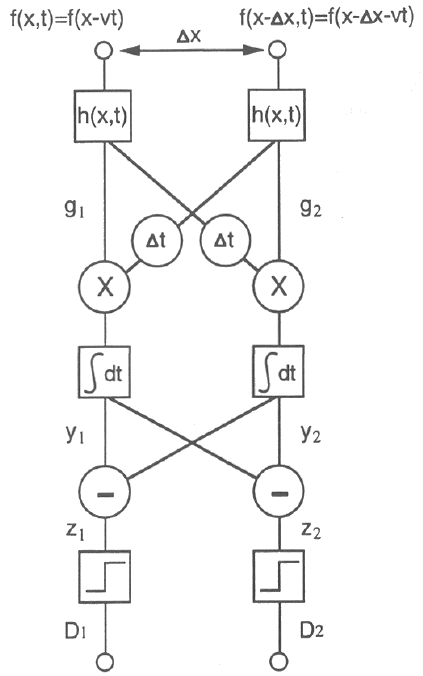This is a more elaborate model based on the same idea as above. As shown in
the figure, the two sensors (receptors) are placed with a distance
![]() apart in 1D space. A spatial pattern moving at velocity v>0 is represented by
f(x,t)=f(x-vt) (v>0 for rightward motion and v<0 for the opposite direction).
The responses of the light sensors to the input signals are, respectively,
apart in 1D space. A spatial pattern moving at velocity v>0 is represented by
f(x,t)=f(x-vt) (v>0 for rightward motion and v<0 for the opposite direction).
The responses of the light sensors to the input signals are, respectively,


Let us first assume a moving pattern is a point light source
![]() .
Then we have
.
Then we have


Obviously, y1 and y2 are both functions of v, the velocity of motion.
When
![]() ,
the two functions in the correlation for
y1 coincide and
,
the two functions in the correlation for
y1 coincide and
![]() reaches maximum, and thus
indicating a motion toward right at velocity v. If v moves away from this
particular value
reaches maximum, and thus
indicating a motion toward right at velocity v. If v moves away from this
particular value
![]() (becoming either larger or smaller
than this value), y1 will become smaller as the two functions in the
correlation will move farther apart from each other and their overlap will
become smaller, until eventually y1 approaches zero when the two functions
are so far apart that they have almost no overlap. It can be seen that
y1(v) now becomes the velocity tuning curve of this velocity sensitive
unit, which can be approximated by a Gaussian function. The width of the tuning
curve is related to both
(becoming either larger or smaller
than this value), y1 will become smaller as the two functions in the
correlation will move farther apart from each other and their overlap will
become smaller, until eventually y1 approaches zero when the two functions
are so far apart that they have almost no overlap. It can be seen that
y1(v) now becomes the velocity tuning curve of this velocity sensitive
unit, which can be approximated by a Gaussian function. The width of the tuning
curve is related to both
![]() and
and
![]() .
The same is true for the other output y2, except that it detects the
velocity in the opposite direction as it reaches maximum when
.
The same is true for the other output y2, except that it detects the
velocity in the opposite direction as it reaches maximum when
![]() .
After subtraction and thresholding, D1 and
D2 are obtained to indicate whether a motion of certain velocity is present.
The above analysis can be generalized from
.
After subtraction and thresholding, D1 and
D2 are obtained to indicate whether a motion of certain velocity is present.
The above analysis can be generalized from
![]() to any spatial moving
pattern f(x-vt).
to any spatial moving
pattern f(x-vt).

Next, we consider a sinusoidal signal
![]() ,
where
,
where ![]() is
its spatial frequency. (Strictly speaking, a constant needs to be added to make
the pattern non-negative) The outputs of the linear system (steady state) are
known to be also sinusoidal:
is
its spatial frequency. (Strictly speaking, a constant needs to be added to make
the pattern non-negative) The outputs of the linear system (steady state) are
known to be also sinusoidal:

Moreover, the above model for 1D motion can be easily generalized to detect 2D motions. More detailed discussion of this model can be found in [20].